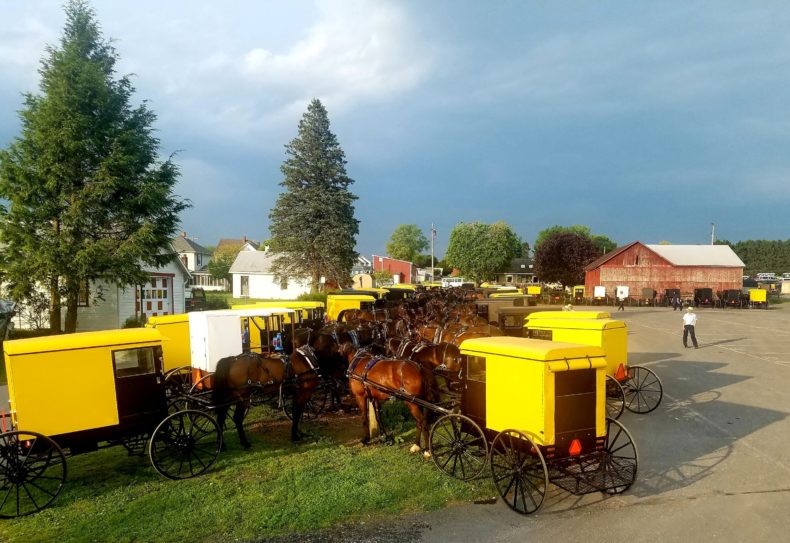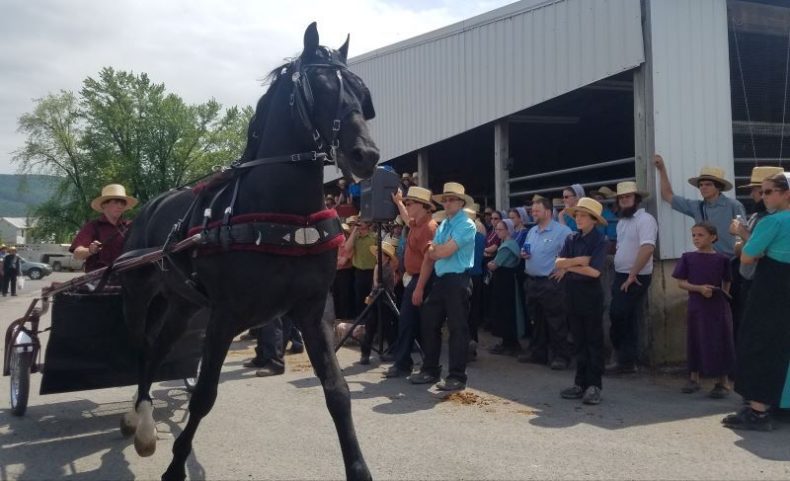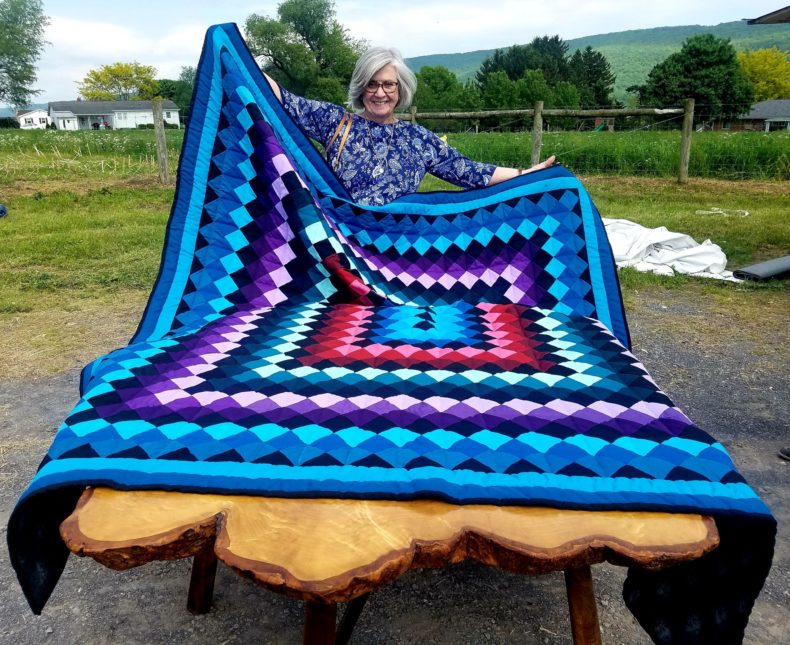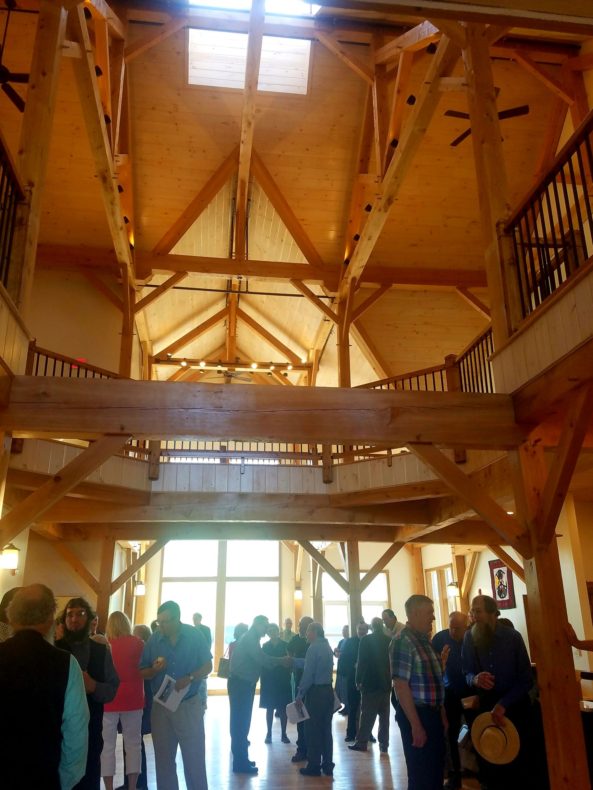
In rural central Pennsylvania, in a long narrow valley originally named Kishacoquillas, now nicknamed Big Valley, the Amish buggies are not black and grey but white and yellow. You might think these unusually bright buggies might signal a more laid-back Amish population, but it’s just the opposite: the two sects represented by the two buggy colors – the Nebraska Amish in white and the Byler Amish in yellow – are the oldest and most conservative Amish churches in the country.
In their quest to simplify, the men of the Nebraska Amish wear no suspenders. The Byler Amish sport a single strap over one shoulder. Neither sect uses zippers or buttons or any form of electricity or telephones or propane or indoor plumbing. But both groups accept modern medicine. So enthusiastically, in fact, that last weekend they raised $280,000 in one day by auctioning quilts, crafts and farm equipment to support the Central Pennsylvania Clinic, a new medical clinic opening in Belleville, in the heart of Big Valley.

Due to their genetic history, the Amish often intersect with medicine, usually with financially ruinous results. The 250,000 Amish people who live in North America are descended from a dozen couples who immigrated from northern Europe to America in the 1700’s. In genetics, a drastic narrowing of the gene pool is known as a population bottleneck. In such a limited gene pool, even if two people aren’t first cousins (a union frowned upon in the Amish church) everybody is so genetically closely related that the chances that two people will both be carriers of the same recessive genes is much higher than in the general population.
To date, over 120 distinct genetic disorders have been identified in the Amish and Mennonite communities. Many of these afflictions are found in the general population, whom the Amish call the English, but at much lower frequencies. For example, one recessive metabolic disorder called glutaric aciduria occurs in 1 in 200,000 English births but in the Amish the incidence is 1 in 200. The Amish are no strangers to suffering. Like all parents, they want their children to thrive and thus they’re open to medical intervention, as long as it’s accessible and affordable. Of course, most major hospitals fail on both counts.
In 1989 my parents Holmes and Caroline Morton brought modern medicine to the Amish, opening the first non-profit clinic in a traditional post and beam building on the edge of an Amish cornfield in Strasburg, Pennsylvania, where most buggies are black or dark grey. Last weekend, my Dad and his brother Paul Morton opened a new clinic that offers lifelong low-cost healthcare to the Amish community, filling the need for everything from screening newborns for genetic diseases, childhood immunizations, treating kids with common childhood illnesses, nutritional and diabetes support for adults and longterm care for those with chronic conditions, both genetic and acquired.
Outsiders may see a stark contrast between the Amish church and modern medicine but the new Central Pennsylvania Clinic exists because of the Plain people and their beliefs, not in spite of them. The Amish are practical people who demand practical medicine and the Clinic is a microcosm of what healthcare can and should be: in service to the health and well-being of the patients, above all else.

Caroline Morton shows off the Amish quilt made of dress scraps the author bought at the auction, displayed on a table made by an Amish bishop
I’ve been attending Amish benefit auctions since childhood and in between watching the quilt auction and visiting the buggy horses, I bring delicious food and cold drinks to my parents, who can hardly walk two steps without somebody wanting to shake their hands – the Amish are big on handshakes. Dad reintroduces me to people who have known me since I was a mud-streaked child who had no trouble holding her own with the barefoot free-range Amish kids.
Of course, they all ask if I’m married and if I have kids and I smile and say no. And then they ask if I still live at home and I say no I live in California and they invariably look at me with complete bewilderment, unable to compute what a 37 year old woman could possibly be doing on her own in a far off place called California. Once, when I was in graduate school, my Dad told an Amishwoman that I teach writing and she asked, “Printing or cursive?”
I cherish every moment of those conversations. Smiling into those confused but kind eyes, I’m reminded that we are free to live our lives anyway we choose. Some of us drive bright yellow buggies and eschew all modern conveniences while supporting cutting edge healthcare and some of us spend years living out of a vehicle on public lands, making a living remotely by relying on some conveniences, like wifi, while forgoing many others.

And some of us build beautiful medical facilities on the edge of cornfields, and run mass spectrometers and gene sequencers while watching one-suspendered Amishmen and mule teams harvest the rows outside, as my Dad has written about in his story, Through My Window. “When we started the clinic in Strasburg, we had no idea that someday we’d be sequencing genes in that building,” he says.
The new clinic building – the frame raised in one day, without a single nail, in the spirit of a traditional Amish barn raising – is 20,000 square feet with six exam rooms and a huge meeting space that will be used for conferences and community functions. Dad says he’s been told many times by Plain people that the building seems too big. He replies, “In a few years, you’ll be glad for the space. You’ll be using it in ways we cannot yet imagine.”
Nobody can predict how the world of medicine will change in the coming years, but some details of this seemingly improbable picture will remain unchanged: horse-drawn white and yellow buggies will pull up to hitching posts in front of a beautiful post and beam building, raised by the ingenuity and generosity of an Old Order community, whose parents simply seek brighter futures for their children.
________
Mary Caperton Morton is a freelance science writer who now lives in California. She used to live all over the place, as documented in her travel blog Travels with the Blonde Coyote. When Erik Vance saw her ode to North America, Aerial Geology, he said he couldn’t think of anything he’d rather do than hole up with that book.
By the way, the new clinic is looking to hire doctors and nurses, if you know any visionaries looking to move to a quiet valley in central PA.
_______
Photos all by the author
I was absolutely captivated while reading this story! I’d love to read more of your material, Mary!
Thank you, Lacrisha! The 500-plus posts on the Blonde Coyote blog should keep you busy for awhile: https://theblondecoyote.com/!
Thank you for sharing this perspective of the world you know. Can’t wait to read your father’s story!